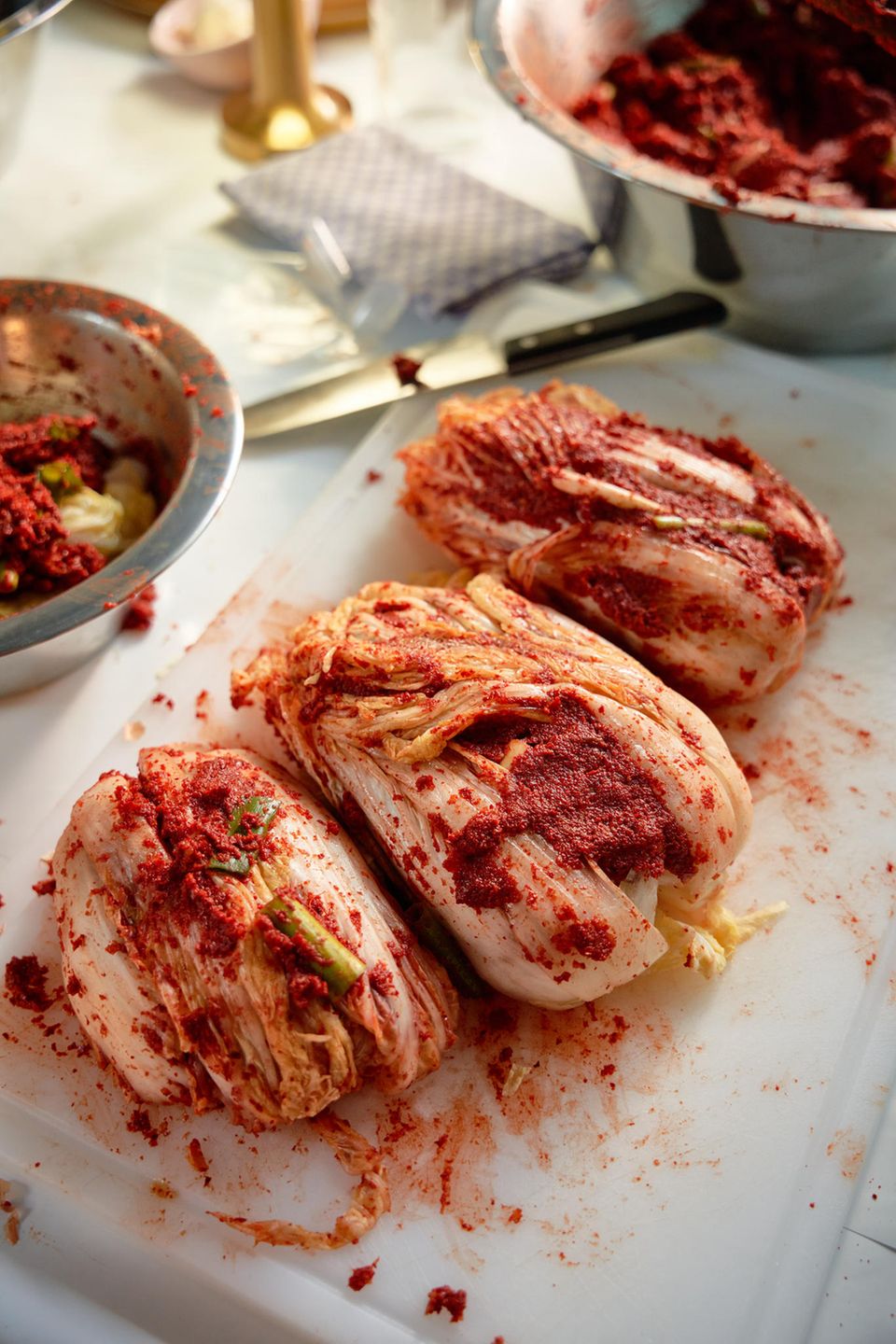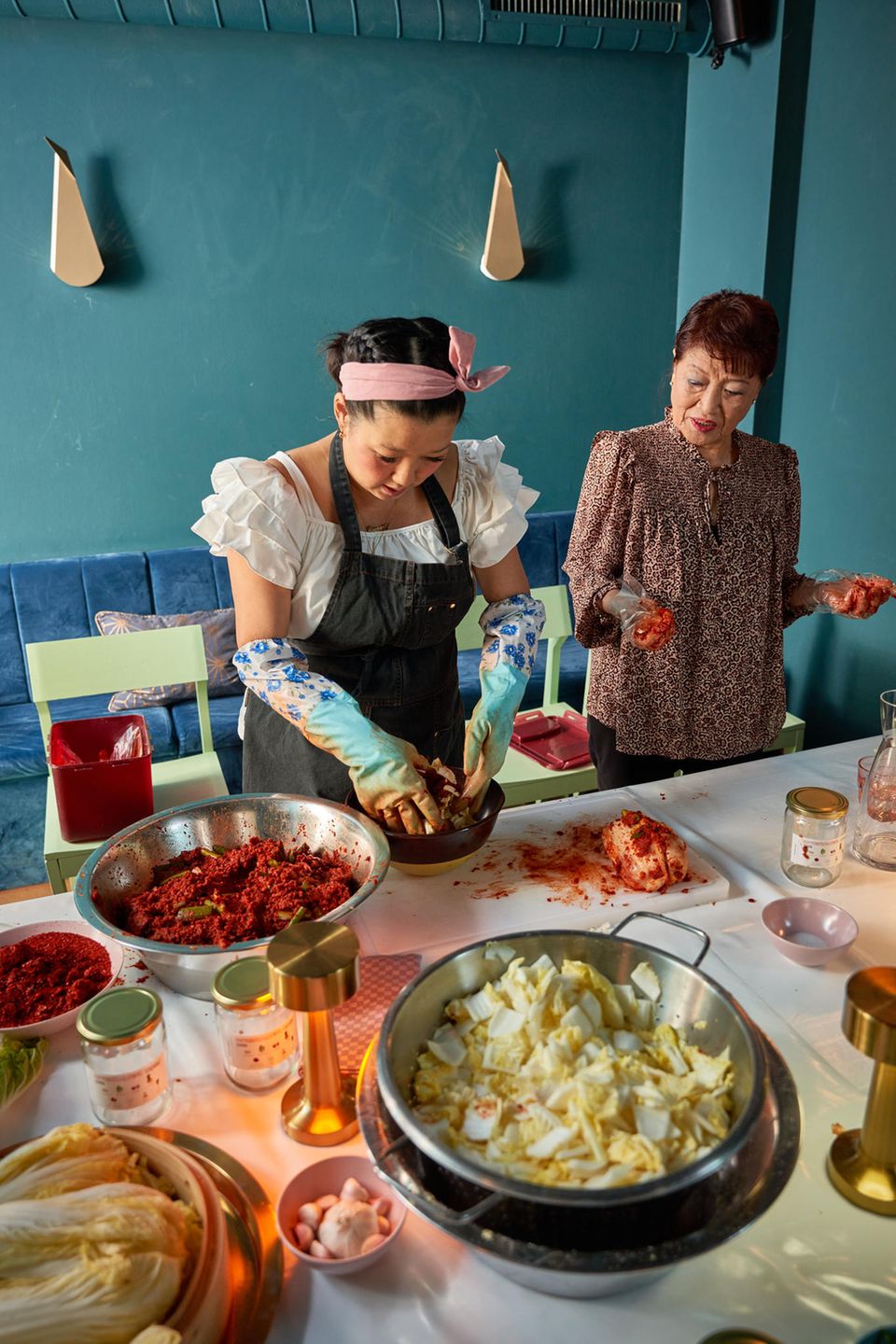Includes kimchi recipe
Susan Choi: How a bartender turns the Berlin bar scene on its head with kimchi
Susan Choi (right) with her mother: Mama Choi
© Jule Frommelt
The cocktail menu at “Mr Susan” sounds extraordinary: Kimchi Margarita, Kimchi Michelada or Korean Paloma. Susan Choi and her husband Robert create drinks based on fermented Chinese cabbage. About a vegetable that is a cultural asset, unites people and tastes particularly good with cheese.
The Chinese cabbage heads are already stacked on the table, waiting to be served: Gimjang Kimchi is not a simple dish, but a comprehensive process. It describes the preparation and preservation of kimchi, the spicy Korean dish made from fermented vegetables. But for Susan Choi, it means much more.
As a Korean American who was born in Germany, grew up in California and opened a bar in Berlin-Mitte, she brings people together with her kimchi. Gimjang takes place exclusively in winter and is a time of sharing and community where families and neighbors come together to prepare large quantities of kimchi to last all winter long. This annual event, practiced for centuries, reflects kimchi’s deep roots in Korean culture.

“Mr Susan’s” kimchi recipe
What you need: 5 kilos of Napa cabbage / Chinese cabbage (approx. 5 heads of cabbage), 300 g salt
For “Mr. Susan’s” kimchi paste: 1 head of garlic, 5 white/yellow onions, 3 spring onions, about 1 kilo, 150 grams of ginger, half a pineapple, about 600 g (canned is OK if not in season), 200 grams of Korean chili flakes, (Optional ) 1-2 chilies of your choice
Preparation:
1. Quarter the cabbage (halve, then halve again)
2. Cut the cabbage into bite-sized pieces, about 3-4 cm
4. Salt the cabbage pieces generously and toss carefully. Make sure the salt is evenly distributed.
5. Let the cabbage sit in the salt for 2-3 hours. The cabbage should become soft and shiny.
6. Carefully wash the salted cabbage pieces, place a handful of each in a sieve. Drain the cabbage. 2-3 hours.
7. In the meantime, prepare the paste. To do this, roughly chop the garlic, onions, spring onions, ginger and pineapple.
8. Place all ingredients in a blender and puree thoroughly. It should look like applesauce. Add water or a little pineapple juice (100 ml) if the paste needs more moisture.
9. After pureeing, add the Korean chili flakes and stir into the paste. The paste should be a bright red color. The consistency should be firm but not dry.
10. Mix the paste thoroughly into the drained cabbage and distribute evenly. YAY KIMCHI! The kimchi tastes very good fresh. BUT for even more flavor – let the fermentation begin.
Tip: Pour kimchi into an airtight container or glass jar and gently press down to press out the air. Cover the top of the kimchi with cling film to prevent air from entering. Let the magic happen. The longer it ferments, the more intense the taste becomes. I love it when it’s about 3 weeks old, my dad only ate kimchi fresh, it couldn’t be older than a week. In Korea there is a delicacy called ‘Mukkeunji’ kimchi that has been fermented for over a year!
Don’t worry about the “champagne effect” because if your kimchi is made correctly, kimchi juice will run out, meaning the fermentation is working. #makeitsparkle
© Jule Frommelt
Susan Choi, who captivates everyone with her infectious personality, has brought in reinforcements: Mama Choi, who introduces the art of kimchi. She marinates whole heads of Chinese cabbage in salt and complains that German Chinese cabbage is much too small – in Korea it is at least twice as big. Despite her long absence from Germany, she speaks German fluently, a skill she acquired in the 1970s before immigrating to the United States with her family.
A traditional gimjang typically uses up to 300 heads of cabbage, but here we make do with a dozen. When the kimchi is fermented, what remains is the spicy paste broth. Susan Choi and her husband Robert have found a creative use for it in their bar: Instead of pouring the broth away, they use it for cocktails – for example, kimchi margaritas, which are mixed with smoky mezcal, or for a kimchi michelada, in which the broth frozen as a popsicle and infused with a pale ale. A non-alcoholic version is also available.
Good kimchi takes time
The Gimjang procedure takes several days if done properly. Some prepare kimchi in a faster way, but for the Choi women it is clear that stuff does not keep up with the kimchi that is prepared over days: For this, the Chinese cabbage is first marinated in salt for at least a day, then it has to be left for several hours Drain before marinating in a paste made from onions, garlic, chilli, ginger, spring onions and other ingredients. Time and lactic acid bacteria are what transform Chinese cabbage into the fermented product that Koreans enjoy with every meal. Kimchi is considered the secret to why Koreans live to old age.
The optimal ripening time for kimchi depends on personal taste: Susan Choi prefers intensively ripened kimchi, while her Mother enjoys it fresh, grown for a maximum of five days. Korean cabbage can easily be fermented for up to five or even ten years. Mama Choi recommends enjoying kimchi with every meal; It can also be used excellently in a vegetable lasagne. Her daughter prefers to eat it fried in butter or with cheese – much to her mother’s dismay. In fact, Susan Choi isn’t wrong about her combination. In an absurd way, the fermented vegetables harmonize particularly well with grilled cheese sandwiches, in the raclette pan or even as a topping on Kässpätzle. The key here is: be brave.
From Seoul to Berlin: pineapple in kimchi

Mama Choi watches her daughter Susan very closely
© Jule Frommelt
There are as many kimchi recipes as there are people in Korea. In Seoul, city dwellers prefer a modern version that Susan Choi also prefers: She adds pineapple to her kimchi for a fruity note, which also provides the sugar that the lactic acid bacteria need for fermentation. Their kimchi is vegan and does not contain dried shrimp like it does in the south is common in Korea. The further south you travel in Korea, the more intensively and frequently the kimchi contains fish and seafood as salty components. Interestingly, kimchi is not limited to a specific type of vegetable. Although Chinese cabbage is the most commonly used, other vegetables such as cucumbers, onions or carrots can also be fermented. Fermented cabbage primarily offers health benefits: The probiotic properties of kimchi are good for the intestines and can contribute to a healthier lifestyle.
Susan Choi also sells her homemade kimchi in her bar “Mr Susan”. They have now prepared 44 batches. Each batch contains 100 kilograms of Chinese cabbage. There is no end in sight.


